--
PedroRio - 17 Dec 2010
XEO Library - Modeling the Entities
In the
last section, you've seen how to use XEO Studio to create the XEO Model for the Author entity (named LIB_Author). Now you'll start by progressively creating the XEO Models for the other entities. To make things easier to explain and also to show XEO's ability to deal with change over time you'll first create some Object Models that do not contain all of their attributes and, as the explanation progresses, add the remaining attributes later on.
You've already learned how to add a textual attribute, define the label, set its length and make it a required attribute (from the previous section), so now you'll make use of that knowledge to define the next entity: the "Book Category". First we'll define a small convention to describe XEO Model to be used in this section of the documentation, which is depicted in the following table:
Object_Model_Name ( Object Model Label)
| Attribute Name |
Attribute Type |
Label |
Description |
Length |
Required |
Object Type |
| Name of the attribute |
Data type of the attribute (Text, Number) |
The label to display for the attribute |
Documentation about the attribute |
Length of the attribute (valid for number/text attributes) |
Whether the attribute is required or not |
The type of Object Models with which the attribute can relate to |
Note: Not all types of attributes have all properties described in the previous table. The value N/A means that the property is Not Applicable to the current attribute
An example may be more clear, for the Book Category entity (
recall the book category entity from previous sections):
LIB_BookCategory ( Book Category)
To create the LIB_BookCategory XEO Model, go to the "File" menu, select "New" and then "XEO Object Model". In the XEO Package field, find the "LIB$1.0" package and in the name type "LIB_BookCategory", in the description you can write "Represents a book category". Press finish and add a "Text" attribute and fill the name field with "name", label with "Name" , description with "Name of the category", length with 30 and in the "Required" section, choose "BOL" from the dropdown menu and type "true" in the field that appears. Your XEO Model should look like the one depicted in figure ME.1 and ME.1a.
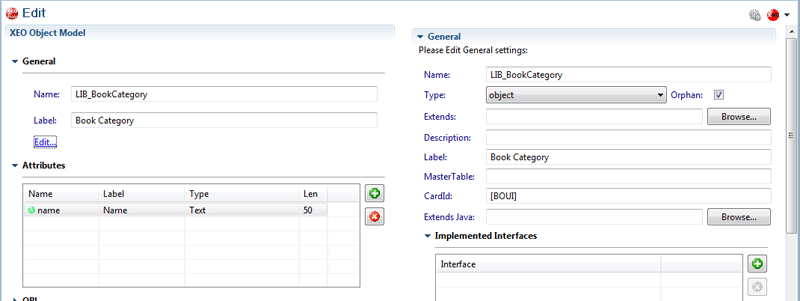 Figure ME.1 - Book Category Object Model
Figure ME.1 - Book Category Object Model
 Figure ME.1a - Book Category Name Attribute
Figure ME.1a - Book Category Name Attribute
Next, create the XEO Models for entities Publisher and Book. Create the Publisher entity as the following (use the new XEO Object Model wizard as before and choose the LIB$1.0 Package):
LIB_Publisher ( Publisher )
Then, create the Book entity with the following definition (also in the LIB$1.0 package):
LIB_Book ( Book )
Save both XEO Models and by now you'll have four XEO Object Models (LIB_Author, LIB_BookCategory, LIB_Publisher and LIB_Book). If you recall from the
introduction, the Book entity had a 1:N relation with authors and categories and a 1:1 relation with publishers. You'll now add those relations to the LIB_Book Object Model.
Adding a 1:1 Relation attribute
You'll begin with the 1:1 relation with publishers. Open the LIB_Book Object Model and add another attribute of type "Object". For the attribute name use "publisher", for the label type "Publisher" and in the description type "Book Publisher". You'll notice that "Object" attributes have a different set of properties from previous attributes created, one of them being the "Type" (highlighted in red in figure ME.2). The type property defines which type of instances (i.e. instances of which XEO Model) can relate to instances of the current XEO Model; in this situation you want that LIB_Book instances have a relation with LIB_Publisher instances so you'll have to select the LIB_Publisher object model.
The default value for the Type property of an Object attribute is
object.boObject. boObject is the super class for all Object Model instances (similar to Object in Java) and you can use it as representation of "any Object Model". The
object.XEOModelName is the syntax used internally but by pressing the "Browse" button (see figure ME.2) you only need to choose from the list of XEO Models in your project (Typing XEO Model names will narrow the list progressively). Choose "LIB_Publisher" as the type for the publisher attribute.
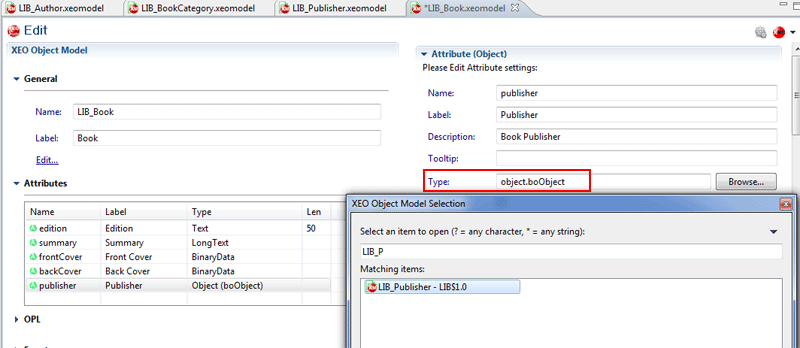 Figure ME.2 - Editing an attribute of type Object (for the LIB_Book Object Model)
Note: Object attributes can have several more properties which will be discussed later in the documentation (for example, it's possible to declare the following: instances "LIB_Book" have a 1:1 relation, through attribute X, with an instance of Model A, Model B or Model C, instead of just one possible target).
Figure ME.2 - Editing an attribute of type Object (for the LIB_Book Object Model)
Note: Object attributes can have several more properties which will be discussed later in the documentation (for example, it's possible to declare the following: instances "LIB_Book" have a 1:1 relation, through attribute X, with an instance of Model A, Model B or Model C, instead of just one possible target).
This is the state of the LIB_Book Object Model after adding the Object Attribute.
LIB_Book ( Book )
To finalize the LIB_Book Object Model you'll need to add the 1:N relations (with Categories and Authors) which will be done in the following section.
Adding a 1:N Relation (Collection) attribute
Collection attributes in XEO Models represent 1:N relations, which are among the most common in XEO Object Modeling. To create a Collection attribute it's required to specify not only the target Object Model(s) but also the cardinality of the relation (minimum an maximum), as usual there are several other options which will be explored later. Check figure ME.3 to see how to create the collection attribute for the "Book Categories" relations.
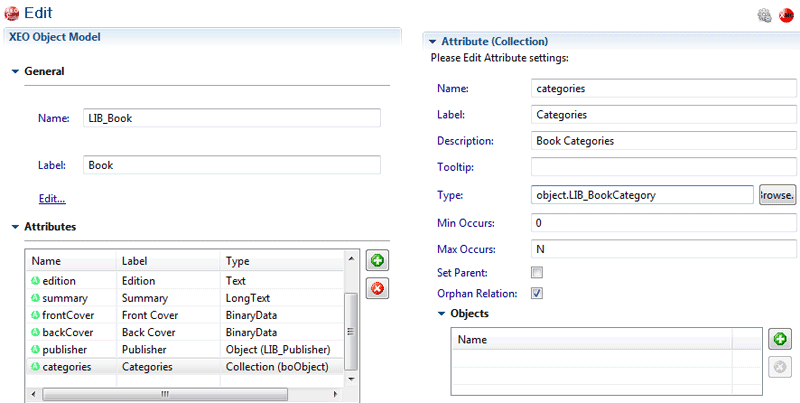 Figure ME.3 - Editing an attribute of type Collection (for the LIB_Book Object Model)
Figure ME.3 - Editing an attribute of type Collection (for the LIB_Book Object Model)
Add another Collection attribute named "authors" (label = Authors, description = "Book Authors", type = LIB_Author). The LIB_Publisher Object Model has a 1:N relation with Publisher Nucleus, and a 1:N relation with Contacts but we'll leave for later. In the next section entities representing users and their interaction with books shall be created. The final LIB_Book entity should be like the following:
LIB_Book ( Book )
| Attribute Name |
Attribute Type |
Label |
Description |
Length |
Required |
Object Type |
| title |
Text |
Title |
Book Title |
100 |
true |
N/A |
| isbn |
Text |
ISBN |
Book ISBN |
13 |
true |
N/A |
| edition |
Text |
Edition |
Book Edition |
30 |
true |
N/A |
| summary |
LongText |
Summary |
The Book's Summary |
N/A |
false |
N/A |
| frontCover |
BinaryData |
Front Cover |
The Book's Front Cover |
N/A |
false |
N/A |
| backCover |
BinaryData |
Back Cover |
The Book's Back Cover |
N/A |
false |
N/A |
publisher
|
Object
|
Publisher
|
The Book's Publisher
|
N/A
|
false
|
LIB_Publisher
|
| categories |
Collection |
Categories |
The list of Book Categories |
N/A |
false |
LIB_BookCategory |
| author |
Collection |
Authors |
The list of Book authors |
N/A |
false |
LIB_Author |
| state |
Text (Lov) |
State |
The state of the book (if it's loaned or in the library |
1 |
true |
N/A |
Notice the state attribute, which represents the state of the book (whether it's in the library or with some library user). The state is an attribute which can have two values (available/unavailable) and instead of using the value 0/1 or true/false in a Number/Boolean attribute and having to make the conversion each time you want to display the value (i.e. to show the string "Available" or "Unavailable) you'll use a XEO Lov (
List
of
Values) which allows you to map keys to values (and you'll map "0" to "Unavailable" and "1" to Available) and integrates directly with the XEO Model, see the next section on how to create a XEO Lov.
Introducing XEO Lovs ( LIB_Book state )
A XEO Lov is a file with the .xeolov extension and it's basically a container for lists of values (i.e. one .xeolov file can have multiple lists of values). Alternatively XEO Model attributes can define their own List of Values, but that list cannot be reused by another attribute (nor in another XEO Model). To create a new XEO Lov file, go the "File" menu, choose "New" -> "XEO Lov", choose the "LIB$1.0" package type the name "LIB_Lov" and press finish.
After finish is pressed, the XEO Lov editor will open (the screen is depicted in figure ME.3a, where the default "lov1" List is chosen)
 Figure ME.3a - XEO Lov Editor
Figure ME.3a - XEO Lov Editor
When a new XEO Lov file is created, a single list of values is created by the name of "lov1" with two items (label1/value1 and label2/value2), use the buttons in the details panel (on the right, in figure ME.3a) to edit the values so that they match the following screen (figure ME.3b) and save the XEO Lov.
 Figure ME.3b - XEO Lov editor with the State Lov values.
Figure ME.3b - XEO Lov editor with the State Lov values.
To finalize the LIB_Book entity the state attribute, must be linked to the "book_state" lov in the LIB_LOV.xeolov file. Open the LIB_Book XEO Model and select the state attribute and scroll down to the "Lov" section in the attribute's details panel. Press the "Browse" button and start typing "book_" in the text field to narrow the choice of lovs, select the "book_state" lov and press ok (see figure ME.3c for details).
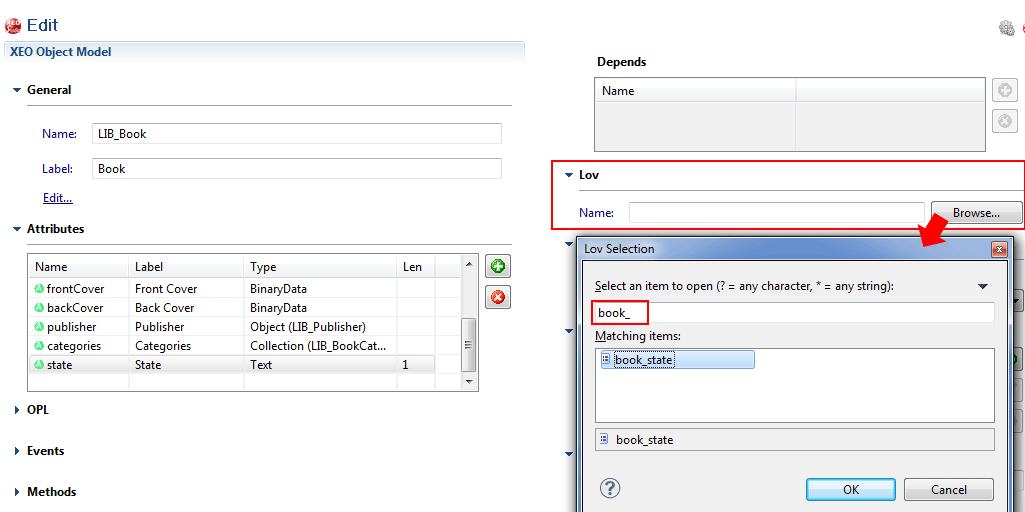 Figure ME.3c - Choosing a lov item for the values of the state attribute in the LIB_Book XEO Model.
Figure ME.3c - Choosing a lov item for the values of the state attribute in the LIB_Book XEO Model.
Save the XEO Model to finalize the changes and proceed to the next section to create the remaining XEO Object Models.
Librarians, Users, Messages, Movements and Returns
In this chapter you'll model the entities that deal with users and their interaction with books. (Librarians and Users, Movements and Returns and finally the Messages librarians can send each other). XEO provides a set of XEO Models that help dealing with users, so the best way is always to reuse one of those. One the XEO Models is the iXEOUser interface which declares a set of attributes (name, username, password, id, e-mail) necessary for user accounts. Librarians and Users will require these attributes and add another attribute which is the library identifier (for users) and library employee identifier (for librarians). The librarian also has a 1:N relation with the messages entity.
Overriding attributes in an implemented interface
It's also possible to override an attribute definition inherited from an implemented interface. This is usually done usually to add custom behavior to that attribute (which may not be present in the interface). In the XEO Library application you'll override the e-mail
and username attribute in both Librarians and Library Users to add custom behavior later on.
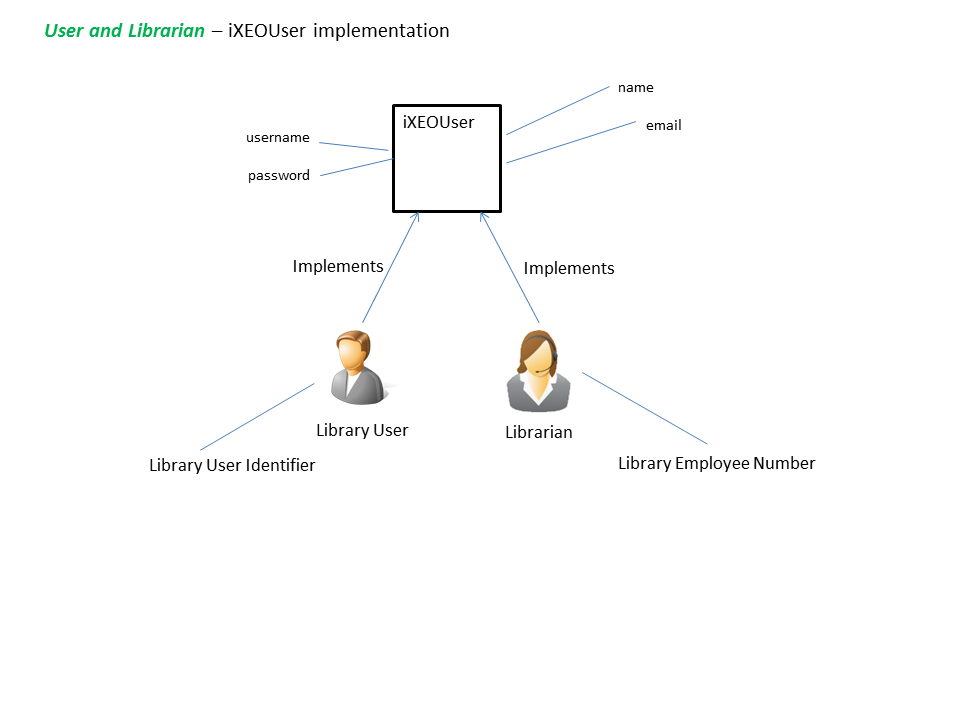 Figure ME.4 - User and Librarian implementing interface iXEOUser and additional attributes regarding user identification
Figure ME.4 - User and Librarian implementing interface iXEOUser and additional attributes regarding user identification
Start by creating the Library User and Librarian models with the following structure (respectively):
LIB_User ( Library User )
| Attribute Name |
Attribute Type |
Label |
Description |
Length |
Required |
Object Type |
Notes |
| userIdentifier |
Number |
Library ID |
Library Identifier |
10 |
true |
N/A |
- |
| active |
Boolean |
Active |
User is Active Flag |
N/A |
false |
N/A |
- |
| email |
Text |
E-mail |
The user's e-mail |
30 |
true |
N/A |
Overrides the attribute in iXEOUser |
| lastname |
Text |
Last Name |
The user's last name |
30 |
true |
N/A |
- |
| username |
Text |
Username |
The username |
30 |
true |
N/A |
- |
LIB_Librarian( Library Employee )
| Attribute Name |
Attribute Type |
Label |
Description |
Length |
Required |
Object Type |
Notes |
| employeeId |
Number |
Employee Number |
Identifier of an Employee |
10 |
true |
N/A |
- |
| email |
Text |
E-mail |
The librarian's e-mail |
30 |
true |
N/A |
Overrides the attribute in iXEOUser |
| lastname |
Text |
Last Name |
The librarian's last name |
30 |
true |
N/A |
- |
| username |
Text |
Username |
The librarian's username |
30 |
true |
N/A |
- |
Now, you must set both the Object Models to implement the iXEOUser interface. Doing so, requires to open each Object Model, find the "General" section and press the "Edit..." button which will open the general properties in the details panel; find the "Implemented Interfaces" section and press the add button. The result is depicted in figure ME.5.
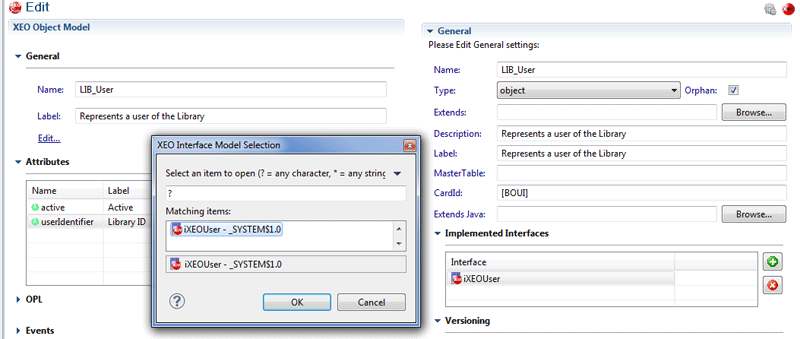 Figure ME.5 - Interface Implementation in XEO Studio
Figure ME.5 - Interface Implementation in XEO Studio
Next, you'll create the Movement entity (representing a Library User taking some books home, from the library). Create the
LIB_Movement Object Model in the LIB$1.0 package as usual) with the following attributes.
LIB_Movement ( Movement )
| Attribute Name |
Attribute Type |
Label |
Description |
Length |
Required |
Object Type |
Notes |
| id |
Sequence |
Id |
Identifier |
10 |
true |
N/A |
|
| dueDate |
Date |
Due Date |
Due date for the movement |
N/A |
true |
N/A |
|
| fine |
Number |
Fine |
Fine to apply to the user of this movement (if delivery not in time) |
10 |
false |
N/A |
|
| user |
Object |
User |
User that took the books home |
N/A |
true |
LIB_User |
|
| books |
Collection |
Books |
Books took by the user |
N/A |
false |
LIB_Book |
|
| state* |
Text (Lov) |
State |
The state of the movement (open / closed) |
1 |
true |
N/A |
Link to "movement_state" lov |
*Create a Lov in LIB_Lov.xeolov named "movement_state" with two items (label/value): "Open" / "0" and "Closed" / "1".
Instances of the Return entity only make sense if there's an instance of the Movement entity to associate them with (you can't return books you haven't taken). Recall from the
XEO Concepts that XEO can declare Object Models which can only exist as children of other Object Models, those were referred to as Orphan and Non-Orphan Object Models. In the case of the return entity it's an example of a non-orphan entity (i.e. it cannot exist as an "orphan", it must have a parent), as such, when creating the Return entity we need to uncheck the "Orphan" box in the XEO Studio Wizard (as depicted in figure ME.5a, highlighted in red).
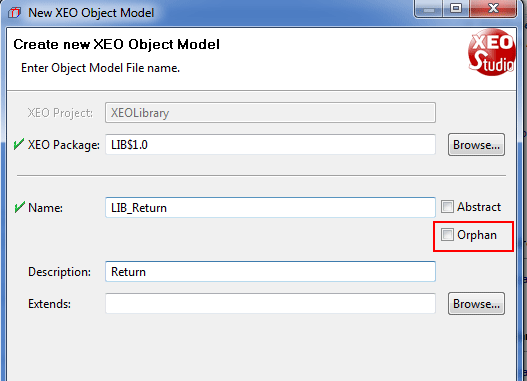 Figure ME.5a - Creating a non-orphan Object Model - LIB_Return
Figure ME.5a - Creating a non-orphan Object Model - LIB_Return
Afterwards create the Return entity with the following attributes:
LIB_Return (Return)
Save the LIB_Return Object Model and add a collection attribute to the LIB_Movement Object Model for the returns, the LIB_Movement entity should have the following structure:
LIB_Movement ( Movement )
| Attribute Name |
Attribute Type |
Label |
Description |
Length |
Required |
Object Type |
| id |
Sequence |
Id |
Identifier |
10 |
true |
N/A |
| dueDate |
Date |
Due Date |
Due date for the movement |
N/A |
true |
N/A |
| fine |
Number |
Fine |
Fine to apply to the user of this movement (if delivery not in time) |
10 |
false |
N/A |
| user |
Object |
User |
User that took the books home |
N/A |
true |
LIB_User |
| books |
Collection |
Books |
Books took by the user |
N/A |
false |
LIB_Book |
| returns |
Collection |
Returns |
List of returns made by the user |
N/A |
false |
LIB_Return |
_
Message and Librarian (finalizing)
Create the Message Object Model with the following structure:
LIB_Message( Message )
| Attribute Name |
Attribute Type |
Label |
Description |
Length |
Required |
Object Type |
| subject |
Text |
Subject |
Subject of the Message |
50 |
true |
N/A |
| bodyMessage |
LongText |
Body |
The body of the message |
N/A |
true |
N/A |
| date |
Date |
Date |
Date of the message |
N/A |
false |
N/A |
| urgent |
Boolean |
Urgent |
Whether the message is urgent or not |
N/A |
false |
N/A |
| recipients |
Collection |
Recipients |
The recipients of the message |
N/A |
false |
boObject* |
* - As explained before, boObject is the generic object type in XEO, which means that using boObject in the type of a collection attribute allows you to relate with any instance of any Object Model. In this situation, however, we only want to allow a message to be delivered to a specific librarian, or to a group of librarians, as such the definition of the recipients attribute should allow to relate to instances of the LIB_Librarian Model or with groups of Librarians. One of XEO's built-in Object Models is the Ebo_Group which represents a group of users in the application and you'll use that for the
recipients attribute. When creating the recipients attribute, choose as type "boObject" and scroll down to the "Objects" section and press the "add" button to add the LIB_Librarian and Ebo_Group Models to the definition,
this will restrict the type of instances for the relation. See figure ME.6 for details.
![Message Object <span class=]() CollectionWithTypes
CollectionWithTypes" src="http://wiki.itds.pt/pub/WebXEO/XeoPrimerObjectModellingLibrary/MessageObjectCollectionWithTypes.png" title="Message Object
CollectionWithTypes" height="344" />
Figure ME.6 - Collection attribute with restrictions to the type of target Object Models.
With the LIB_Message XEO Model complete, you just need to add a collection attribute to the LIB_Librarian so that it keeps track of what messages it has sent. The final structure for the LIB_Librarian Object is the following:
LIB_Librarian( Library Employee )
| Attribute Name |
Attribute Type |
Label |
Description |
Length |
Required |
Object Type |
| employeeId |
Number |
Employee Number |
Identifier of an Employee |
10 |
true |
N/A |
| messages |
Collection |
Messages |
Messages sent by this librarian |
N/A |
false |
LIB_Message |
| email |
Text |
E-Mail |
The librarian's e-mail |
30 |
true |
N/A |
| lastname |
Text |
Last Name |
The librarian's last name |
50 |
false |
N/A |
| username |
Text |
Username |
The librarian's username |
50 |
true |
N/A |
To finalize the entity modeling, the only remaining entities are the Contact and Publisher Nucleus, which you'll create in the next section.
Contact and Publisher Nucleus
A contact is an entity to help represent the contacts of people connected to the publishers and their nucleus, thus it only makes sense when connected to those entities and should be created as a non-orphan entity. The definition of a contact is the following (create it in the LIB$1.0 package):
LIB_Contact( Contact )
The Publisher Nucleus entity can only exist when a parent Publisher is responsible for it, as such, the LIB_PublisherNucleus is a non-orphan Object Model (uncheck the "Orphan" option in the new XEO Model wizard), which has the following structure:
LIB_PublisherNucleus( Publisher Nucleus )
Also, you need to change the LIB_Publisher XEO Model (adding the relation to contacts). The final definition for the LIB_Publisher XEO Model is the following:
LIB_Publisher ( Publisher )
Save all open XEO Models and you've finalized the initial modeling of the XEO Library entities.
Jump to the next chapter to know how to add behavior to the XEO Models.
 WebXEO Web>XeoPrimer>XeoPrimerObjectModellingLibrary (2011-04-04, NicolauGrosskopf)
WebXEO Web>XeoPrimer>XeoPrimerObjectModellingLibrary (2011-04-04, NicolauGrosskopf) EditAttach
EditAttach Figure ME.1 - Book Category Object Model
Figure ME.1 - Book Category Object Model
 Figure ME.1a - Book Category Name Attribute
Next, create the XEO Models for entities Publisher and Book. Create the Publisher entity as the following (use the new XEO Object Model wizard as before and choose the LIB$1.0 Package):
LIB_Publisher ( Publisher )
Figure ME.1a - Book Category Name Attribute
Next, create the XEO Models for entities Publisher and Book. Create the Publisher entity as the following (use the new XEO Object Model wizard as before and choose the LIB$1.0 Package):
LIB_Publisher ( Publisher )
 Figure ME.2 - Editing an attribute of type Object (for the LIB_Book Object Model)
Note: Object attributes can have several more properties which will be discussed later in the documentation (for example, it's possible to declare the following: instances "LIB_Book" have a 1:1 relation, through attribute X, with an instance of Model A, Model B or Model C, instead of just one possible target).
This is the state of the LIB_Book Object Model after adding the Object Attribute.
Figure ME.2 - Editing an attribute of type Object (for the LIB_Book Object Model)
Note: Object attributes can have several more properties which will be discussed later in the documentation (for example, it's possible to declare the following: instances "LIB_Book" have a 1:1 relation, through attribute X, with an instance of Model A, Model B or Model C, instead of just one possible target).
This is the state of the LIB_Book Object Model after adding the Object Attribute. Figure ME.3 - Editing an attribute of type Collection (for the LIB_Book Object Model)
Add another Collection attribute named "authors" (label = Authors, description = "Book Authors", type = LIB_Author). The LIB_Publisher Object Model has a 1:N relation with Publisher Nucleus, and a 1:N relation with Contacts but we'll leave for later. In the next section entities representing users and their interaction with books shall be created. The final LIB_Book entity should be like the following:
LIB_Book ( Book )
Figure ME.3 - Editing an attribute of type Collection (for the LIB_Book Object Model)
Add another Collection attribute named "authors" (label = Authors, description = "Book Authors", type = LIB_Author). The LIB_Publisher Object Model has a 1:N relation with Publisher Nucleus, and a 1:N relation with Contacts but we'll leave for later. In the next section entities representing users and their interaction with books shall be created. The final LIB_Book entity should be like the following:
LIB_Book ( Book )
 Figure ME.3a - XEO Lov Editor
When a new XEO Lov file is created, a single list of values is created by the name of "lov1" with two items (label1/value1 and label2/value2), use the buttons in the details panel (on the right, in figure ME.3a) to edit the values so that they match the following screen (figure ME.3b) and save the XEO Lov.
Figure ME.3a - XEO Lov Editor
When a new XEO Lov file is created, a single list of values is created by the name of "lov1" with two items (label1/value1 and label2/value2), use the buttons in the details panel (on the right, in figure ME.3a) to edit the values so that they match the following screen (figure ME.3b) and save the XEO Lov.
 Figure ME.3b - XEO Lov editor with the State Lov values.
To finalize the LIB_Book entity the state attribute, must be linked to the "book_state" lov in the LIB_LOV.xeolov file. Open the LIB_Book XEO Model and select the state attribute and scroll down to the "Lov" section in the attribute's details panel. Press the "Browse" button and start typing "book_" in the text field to narrow the choice of lovs, select the "book_state" lov and press ok (see figure ME.3c for details).
Figure ME.3b - XEO Lov editor with the State Lov values.
To finalize the LIB_Book entity the state attribute, must be linked to the "book_state" lov in the LIB_LOV.xeolov file. Open the LIB_Book XEO Model and select the state attribute and scroll down to the "Lov" section in the attribute's details panel. Press the "Browse" button and start typing "book_" in the text field to narrow the choice of lovs, select the "book_state" lov and press ok (see figure ME.3c for details).
 Figure ME.3c - Choosing a lov item for the values of the state attribute in the LIB_Book XEO Model.
Save the XEO Model to finalize the changes and proceed to the next section to create the remaining XEO Object Models.
Figure ME.3c - Choosing a lov item for the values of the state attribute in the LIB_Book XEO Model.
Save the XEO Model to finalize the changes and proceed to the next section to create the remaining XEO Object Models.
 Figure ME.4 - User and Librarian implementing interface iXEOUser and additional attributes regarding user identification
Start by creating the Library User and Librarian models with the following structure (respectively):
LIB_User ( Library User )
Figure ME.4 - User and Librarian implementing interface iXEOUser and additional attributes regarding user identification
Start by creating the Library User and Librarian models with the following structure (respectively):
LIB_User ( Library User )
 Figure ME.5 - Interface Implementation in XEO Studio
Next, you'll create the Movement entity (representing a Library User taking some books home, from the library). Create the LIB_Movement Object Model in the LIB$1.0 package as usual) with the following attributes.
LIB_Movement ( Movement )
Figure ME.5 - Interface Implementation in XEO Studio
Next, you'll create the Movement entity (representing a Library User taking some books home, from the library). Create the LIB_Movement Object Model in the LIB$1.0 package as usual) with the following attributes.
LIB_Movement ( Movement )
 Figure ME.5a - Creating a non-orphan Object Model - LIB_Return
Afterwards create the Return entity with the following attributes:
LIB_Return (Return)
Figure ME.5a - Creating a non-orphan Object Model - LIB_Return
Afterwards create the Return entity with the following attributes:
LIB_Return (Return)
![Message Object <span class=]() CollectionWithTypes" src="http://wiki.itds.pt/pub/WebXEO/XeoPrimerObjectModellingLibrary/MessageObjectCollectionWithTypes.png" title="Message Object CollectionWithTypes" height="344" />
Figure ME.6 - Collection attribute with restrictions to the type of target Object Models.
With the LIB_Message XEO Model complete, you just need to add a collection attribute to the LIB_Librarian so that it keeps track of what messages it has sent. The final structure for the LIB_Librarian Object is the following:
LIB_Librarian( Library Employee )
CollectionWithTypes" src="http://wiki.itds.pt/pub/WebXEO/XeoPrimerObjectModellingLibrary/MessageObjectCollectionWithTypes.png" title="Message Object CollectionWithTypes" height="344" />
Figure ME.6 - Collection attribute with restrictions to the type of target Object Models.
With the LIB_Message XEO Model complete, you just need to add a collection attribute to the LIB_Librarian so that it keeps track of what messages it has sent. The final structure for the LIB_Librarian Object is the following:
LIB_Librarian( Library Employee )
 Figure ME.1 - Book Category Object Model
Figure ME.1 - Book Category Object Model
 Figure ME.1a - Book Category Name Attribute
Next, create the XEO Models for entities Publisher and Book. Create the Publisher entity as the following (use the new XEO Object Model wizard as before and choose the LIB$1.0 Package):
LIB_Publisher ( Publisher )
Figure ME.1a - Book Category Name Attribute
Next, create the XEO Models for entities Publisher and Book. Create the Publisher entity as the following (use the new XEO Object Model wizard as before and choose the LIB$1.0 Package):
LIB_Publisher ( Publisher )
 Figure ME.2 - Editing an attribute of type Object (for the LIB_Book Object Model)
Note: Object attributes can have several more properties which will be discussed later in the documentation (for example, it's possible to declare the following: instances "LIB_Book" have a 1:1 relation, through attribute X, with an instance of Model A, Model B or Model C, instead of just one possible target).
This is the state of the LIB_Book Object Model after adding the Object Attribute.
Figure ME.2 - Editing an attribute of type Object (for the LIB_Book Object Model)
Note: Object attributes can have several more properties which will be discussed later in the documentation (for example, it's possible to declare the following: instances "LIB_Book" have a 1:1 relation, through attribute X, with an instance of Model A, Model B or Model C, instead of just one possible target).
This is the state of the LIB_Book Object Model after adding the Object Attribute. Figure ME.3 - Editing an attribute of type Collection (for the LIB_Book Object Model)
Add another Collection attribute named "authors" (label = Authors, description = "Book Authors", type = LIB_Author). The LIB_Publisher Object Model has a 1:N relation with Publisher Nucleus, and a 1:N relation with Contacts but we'll leave for later. In the next section entities representing users and their interaction with books shall be created. The final LIB_Book entity should be like the following:
LIB_Book ( Book )
Figure ME.3 - Editing an attribute of type Collection (for the LIB_Book Object Model)
Add another Collection attribute named "authors" (label = Authors, description = "Book Authors", type = LIB_Author). The LIB_Publisher Object Model has a 1:N relation with Publisher Nucleus, and a 1:N relation with Contacts but we'll leave for later. In the next section entities representing users and their interaction with books shall be created. The final LIB_Book entity should be like the following:
LIB_Book ( Book )
 Figure ME.3a - XEO Lov Editor
When a new XEO Lov file is created, a single list of values is created by the name of "lov1" with two items (label1/value1 and label2/value2), use the buttons in the details panel (on the right, in figure ME.3a) to edit the values so that they match the following screen (figure ME.3b) and save the XEO Lov.
Figure ME.3a - XEO Lov Editor
When a new XEO Lov file is created, a single list of values is created by the name of "lov1" with two items (label1/value1 and label2/value2), use the buttons in the details panel (on the right, in figure ME.3a) to edit the values so that they match the following screen (figure ME.3b) and save the XEO Lov.
 Figure ME.3b - XEO Lov editor with the State Lov values.
To finalize the LIB_Book entity the state attribute, must be linked to the "book_state" lov in the LIB_LOV.xeolov file. Open the LIB_Book XEO Model and select the state attribute and scroll down to the "Lov" section in the attribute's details panel. Press the "Browse" button and start typing "book_" in the text field to narrow the choice of lovs, select the "book_state" lov and press ok (see figure ME.3c for details).
Figure ME.3b - XEO Lov editor with the State Lov values.
To finalize the LIB_Book entity the state attribute, must be linked to the "book_state" lov in the LIB_LOV.xeolov file. Open the LIB_Book XEO Model and select the state attribute and scroll down to the "Lov" section in the attribute's details panel. Press the "Browse" button and start typing "book_" in the text field to narrow the choice of lovs, select the "book_state" lov and press ok (see figure ME.3c for details).
 Figure ME.3c - Choosing a lov item for the values of the state attribute in the LIB_Book XEO Model.
Save the XEO Model to finalize the changes and proceed to the next section to create the remaining XEO Object Models.
Figure ME.3c - Choosing a lov item for the values of the state attribute in the LIB_Book XEO Model.
Save the XEO Model to finalize the changes and proceed to the next section to create the remaining XEO Object Models.
 Figure ME.4 - User and Librarian implementing interface iXEOUser and additional attributes regarding user identification
Start by creating the Library User and Librarian models with the following structure (respectively):
LIB_User ( Library User )
Figure ME.4 - User and Librarian implementing interface iXEOUser and additional attributes regarding user identification
Start by creating the Library User and Librarian models with the following structure (respectively):
LIB_User ( Library User )
 Figure ME.5 - Interface Implementation in XEO Studio
Next, you'll create the Movement entity (representing a Library User taking some books home, from the library). Create the LIB_Movement Object Model in the LIB$1.0 package as usual) with the following attributes.
LIB_Movement ( Movement )
Figure ME.5 - Interface Implementation in XEO Studio
Next, you'll create the Movement entity (representing a Library User taking some books home, from the library). Create the LIB_Movement Object Model in the LIB$1.0 package as usual) with the following attributes.
LIB_Movement ( Movement )
 Figure ME.5a - Creating a non-orphan Object Model - LIB_Return
Afterwards create the Return entity with the following attributes:
LIB_Return (Return)
Figure ME.5a - Creating a non-orphan Object Model - LIB_Return
Afterwards create the Return entity with the following attributes:
LIB_Return (Return)

